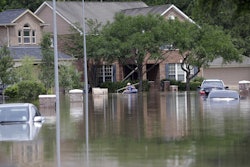IDAHO FALLS, Idaho (AP) — A darkened central control room with more than 25 computer screens watches over nearly everything occurring inside this radioactive waste treatment plant west of Idaho Falls.
The room is where employees at the Advanced Mixed Waste Treatment Project, or AMWTP, monitor and manipulate the facility's dangerous waste treatment process from afar. Decades-old metal boxes and drums filled with radioactive waste travel through a series of conveyor belts and elevators. At various stages the waste is remotely sorted, repackaged, smashed up, and then packaged again. A final product of multiple 55-gallon drums is shipped on trucks to waste repositories located in New Mexico, Nevada and Utah.
The facility — which employs about 700 and has operated for more than a dozen years — is undergoing an approximately $10 million overhaul. Officials hope the new infrastructure will help finish the job of treating some 65,000 cubic meters of Idaho's transuranic nuclear waste before a looming 2018 deadline.
Meanwhile, U.S. Department of Energy officials are pondering what to do with the specialized plant once its current mission is complete. One tentative post-2018 plan would mean shipping nuclear waste to the Idaho facility from DOE sites spread around the country. The waste would be treated and packaged here, then sent onward to a final resting place outside the state.
"There is no other capability like Advanced Mixed Waste in the DOE complex," said Dave Richardson, the project's manager for contractor Idaho Treatment Group. He said its infrastructure is worth about $1 billion.
"The question is, what do you want to do with this facility?"
The AMWTP was built to treat 65,000 cubic meters of transuranic waste that was buried nearby in the Arco desert in the 1970s and '80s. It came from the now-closed Rocky Flats Plant near Denver, where nuclear weapon components were made.
Held in slowly deteriorating metal, wooden and fiberglass boxes and metal drums, the waste includes tools, rags, clothing, sludge and dirt — anything contaminated with a transuranic element, such as plutonium, during the weapon-making process.
Workers at the facility have been chipping away at the massive pile of waste for years. It's a painfully slow process that since 2011 has been handled by Idaho Treatment Group. This summer a new government contractor, Fluor, will take over management of the job, along with other waste cleanup duties on the desert site.
Richardson said there are about 12,000 cubic meters still to get through. All the waste is supposed to be treated and shipped out of Idaho by the end of 2018 under a state deadline laid out in the 1995 Idaho Settlement Agreement with the DOE.
But the DOE and Idaho Treatment Group have run into recent problems. A New Mexico waste repository where much of the waste needs to be sent remains closed after an accident last year. That means about 20,000 ready-to-ship containers of waste have stacked up, with nowhere to go.
In addition, officials said the plant is starting to get worn down, with more frequent repairs costing time that should've been spent treating waste. Richardson said he brought the problem up with DOE officials last year.
"My point to DOE was, you've got to invest some money here, because you've got a sprint to the finish line to get to the milestone agreement in December 2018," Richardson said.
The biggest upgrade for the facility — costing about $4 million — is the replacement of two big remote-controlled robotic arms. The arms are operated in adjacent rooms by workers using joysticks. They sort through waste, sometimes chopping it into more manageable pieces, before repackaging it into new containers. The robotic devices were recently shipped to Idaho from the Swedish company Brokk.
The current robotic arms were needing to be fixed more and more, said Mike Auble, a senior project manager overseeing the upgrades. It's no easy or cheap task when repairs are needed in a highly radioactive area, he said.
Every time one of the robotic arms or another component broke down, a worker would dress up in an astronaut-like protective suit connected to an oxygen line and go into the contaminated area to try and fix the problem. Considering all the safety logistics, Auble said, each entry cost about $7,000. Last year there were about 1,000 such entries — $7 million worth — to fix problems with the robotic arms and other equipment.
A number of other pieces of infrastructure will soon be replaced inside the facility, too, from conveyor belts, to elevators and new hardware and software.
Auble said despite nearing completion of waste treatment, the millions of dollars in upgrades were necessary. The last batch of waste to be treated will be particularly demanding, he said. Much of the waste still to go is the radioactive remnants of a 1969 fire at Rocky Flats. It includes big chunks of contaminated metals, wood, plastic and other radioactive material.
"While the end is in sight, it is by no means easy," he said. "This is the hardest waste to process."
Whenever the current pile of radioactive waste is gone, the DOE must decide what to do next with the facility. Considering it is the only plant of its kind in the U.S. — there is a similar version in the United Kingdom — there may be reason to keep it around.
Sinking millions of federal dollars into AMWTP now won't hurt its long-term prospects, either, something contractor officials are well aware of.
If the facility were to continue treating waste, where would it come from? Mostly the Hanford Site in Washington and Los Alamos National Laboratory in New Mexico, along with lesser amounts from handful of other DOE sites, according to a DOE PowerPoint presentation on the subject. Those two sites have more than 25,000 cubic meters of waste that could be treated at AMWTP, the presentation said, which could keep the facility running for years.
The Idaho Settlement Agreement requires the current transuranic waste to leave the state by the end of 2018. But waste from elsewhere is allowed to enter the state — and long as it is treated and shipped out within one year. Treating waste from DOE sites outside the state has already been done several times at the facility.
There could end up being significant opposition to a life extension for the facility, said Beatrice Brailsford, nuclear program director for the watchdog group Snake River Alliance. Many Idahoans don't have much trust in the DOE when it comes to nuclear waste, she said. As an example, she said, spent nuclear fuel shipped here over the years hasn't left.
"Fundamentally, I think most people in Idaho are nervous about waste coming in," Brailsford said.
On a recent lobbying trip to Washington, D.C., local mayors and economic development officials encouraged DOE to keep the facility up and running, considering it provides hundreds of local jobs. The Idaho National Laboratory Site Citizens Advisory Board also issued a letter to the department in late 2014, saying it was in favor of keeping the plant running.
"AMWTP has already proven it can be a national asset by receiving and processing transuranic waste from 13 different DOE site offices across the country," the letter said.
___
Information from: Post Register, https://www.postregister.com/






















